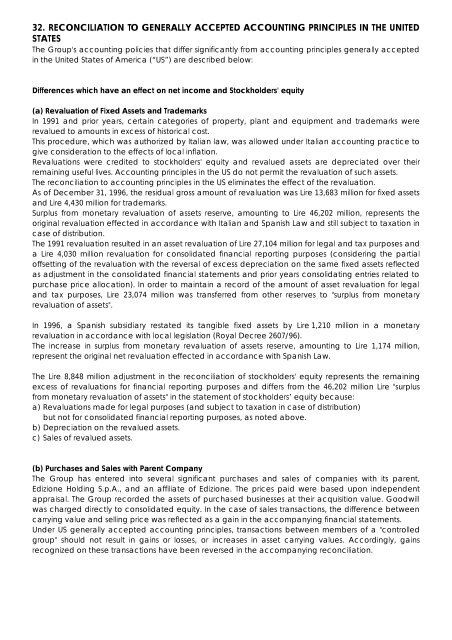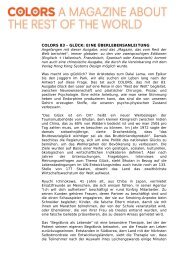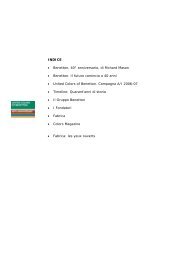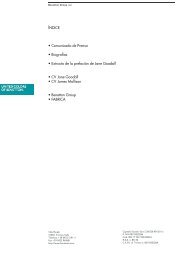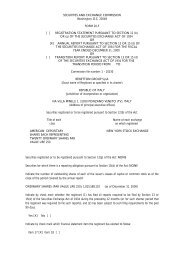The Benetton Group Annual Report 1996
The Benetton Group Annual Report 1996
The Benetton Group Annual Report 1996
Create successful ePaper yourself
Turn your PDF publications into a flip-book with our unique Google optimized e-Paper software.
32. RECONCILIATION TO GENERALLY ACCEPTED ACCOUNTING PRINCIPLES IN THE UNITED<br />
STATES<br />
<strong>The</strong> <strong>Group</strong>'s accounting policies that differ significantly from accounting principles generally accepted<br />
in the United States of America (“US”) are described below:<br />
Differences which have an effect on net income and Stockholders' equity<br />
(a) Revaluation of Fixed Assets and Trademarks<br />
In 1991 and prior years, certain categories of property, plant and equipment and trademarks were<br />
revalued to amounts in excess of historical cost.<br />
This procedure, which was authorized by Italian law, was allowed under Italian accounting practice to<br />
give consideration to the effects of local inflation.<br />
Revaluations were credited to stockholders' equity and revalued assets are depreciated over their<br />
remaining useful lives. Accounting principles in the US do not permit the revaluation of such assets.<br />
<strong>The</strong> reconciliation to accounting principles in the US eliminates the effect of the revaluation.<br />
As of December 31, <strong>1996</strong>, the residual gross amount of revaluation was Lire 13,683 million for fixed assets<br />
and Lire 4,430 million for trademarks.<br />
Surplus from monetary revaluation of assets reserve, amounting to Lire 46,202 million, represents the<br />
original revaluation effected in accordance with Italian and Spanish Law and still subject to taxation in<br />
case of distribution.<br />
<strong>The</strong> 1991 revaluation resulted in an asset revaluation of Lire 27,104 million for legal and tax purposes and<br />
a Lire 4,030 million revaluation for consolidated financial reporting purposes (considering the partial<br />
offsetting of the revaluation with the reversal of excess depreciation on the same fixed assets reflected<br />
as adjustment in the consolidated financial statements and prior years consolidating entries related to<br />
purchase price allocation). In order to maintain a record of the amount of asset revaluation for legal<br />
and tax purposes, Lire 23,074 million was transferred from other reserves to "surplus from monetary<br />
revaluation of assets".<br />
In <strong>1996</strong>, a Spanish subsidiary restated its tangible fixed assets by Lire 1,210 million in a monetary<br />
revaluation in accordance with local legislation (Royal Decree 2607/96).<br />
<strong>The</strong> increase in surplus from monetary revaluation of assets reserve, amounting to Lire 1,174 million,<br />
represent the original net revaluation effected in accordance with Spanish Law.<br />
<strong>The</strong> Lire 8,848 million adjustment in the reconciliation of stockholders' equity represents the remaining<br />
excess of revaluations for financial reporting purposes and differs from the 46,202 million Lire "surplus<br />
from monetary revaluation of assets" in the statement of stockholders’ equity because:<br />
a) Revaluations made for legal purposes (and subject to taxation in case of distribution)<br />
?? but not for consolidated financial reporting purposes, as noted above.<br />
b) Depreciation on the revalued assets.<br />
c) Sales of revalued assets.<br />
(b) Purchases and Sales with Parent Company<br />
<strong>The</strong> <strong>Group</strong> has entered into several significant purchases and sales of companies with its parent,<br />
Edizione Holding S.p.A., and an affiliate of Edizione. <strong>The</strong> prices paid were based upon independent<br />
appraisal. <strong>The</strong> <strong>Group</strong> recorded the assets of purchased businesses at their acquisition value. Goodwill<br />
was charged directly to consolidated equity. In the case of sales transactions, the difference between<br />
carrying value and selling price was reflected as a gain in the accompanying financial statements.<br />
Under US generally accepted accounting principles, transactions between members of a "controlled<br />
group" should not result in gains or losses, or increases in asset carrying values. Accordingly, gains<br />
recognized on these transactions have been reversed in the accompanying reconciliation.


